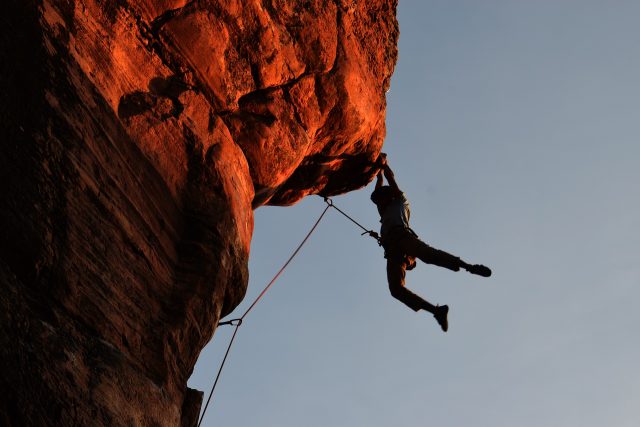Hang in there: The most common types of climbing handholds

Every single rock face that you’ll ever attempt to climb will involve a variety of different grips, or handholds. Handholds are the parts of the rock that are grip-friendly and are what you use in pulling yourself up the rock. You would then push yourself up with your legs (although, you may need to push yourself up with your hands if you are to use a palming move).
The use of handholds while climbing is, of course, somewhat intuitive, since your arms and hands know how to move around and react to different kinds of rock formation to maintain balance and progress the climb. The following are the most common gripping techniques you’ll be using when out on the rock.
Edges

Edges are perhaps the most common type of handhold that you will encounter when climbing. Usually, edges are horizontal with a positive outside edge that can also be rounded as opposed to sharp-edged. Some edges have a flat face that enables you to pull into them while progressing up. The size and length of the edges vary greatly, with some only a few inches long while others can be as wide as your hand. A big edge, either rounded or sharp-edged, is usually called a bucket or a jug.
Depending upon the type of edges you are encountering, there are mostly two basic ways of utilizing them: using a crimp or an open hand grip. If the rock has a smaller and sharper edge, you are better off using a crimp, where you will use your fingertips to get hold of the edge, while at the same time using your fingers to exert pressure on the fingertips by forming an arch above them with your knuckles.

But beware: if not done properly, using a crimp can significantly damage your finger tendons, so best to work up to crimps slowly by practicing on a climbing wall or by selecting appropriate routes. In an open hand grip, a climber is able to grab the edge to pull himself up, since the area of the edge is good and makes for a less challenging handhold.
Slopers

As the name suggests, slopers are usually big chunks of rocks sticking out or sloping. This kind of handhold is often well rounded and thick, and do not have a defined edge or a lip to provide a secure grip.
However, the wider surface area provides enough space to grab hold of the rock. If slopers are right above the climber, it’s considered an ideal sloper as it makes it easier for the climber to straighten his arm and exert maximum pull to utilize the sloper. However, if you are climbing in warm and sweaty conditions, slopers can present serious challenges as sweaty palms and fingers could significantly decrease the friction between hands and the rock surface.
Pinches
![Joshua Harrington enjoying that perfect pinch on Magnolia Bulge [V4] during the trail day. – Author: Steven Sloan – CC BY-NC-ND 2.0](https:/wp-content/uploads/sites/59/2017/06/2173203318_23a2a7f7b8_z-425x640.jpg)
Using pinches to pull yourself up, like crimps, can be a strenuous task, but if you have the next handhold in sight, you can simply use a pinch to principally retain balance as you reach to the other handhold. However, you will need to make sure the pinch is strong enough to enable you to do this.
Pockets

Often ignored by the beginners, pockets are the handholds that could be helpful due to their nature. Pockets are usually holes in the rock that you can utilize by putting a couple of fingers in and then firmly planting your other fingers and palm under or around the hole.
Very much like the slopers, a pocket is easier to use if it’s somewhat above the climber and not on the side; as a pocket right above you will enable to use the length of your arm to increase the intensity of your pull, which you will probably not get with a side pocket.
Sidepulls

Sidepull handholds are very much like an edge, but this time located on your side and is often diagonally or vertically oriented. Though climbers don’t usually like to encounter a handhold on the side because it requires much more work and force and provides less stability, sidepulls are often seen as quite convenient handholds.
Due to the wider area of sidepulls, climbers can grip the rock using all four fingers and then place the thumb as a support on the outer surface. Climbers will then use their legs to compliment the grip to move up.
Gastons
A Gaston, pronounced gas-tone, is very similar to a sidepull and is named after the successful and stylish French climber Gaston Rebuffat. Resembling a sidepull in its orientation as its edges are often diagonally or vertically located, Gastons are usually located near your torso or face and not right above or out to one side.

The best way to grip a Gaston is to firmly place your fingers on its edge with your thumb pointing downward. Since the location of the handhold is such that there is less distance between you and it, you will need to bend your elbows to transfer the exerted pressure required to use this grip. To effectively pull yourself up on a Gaston, you will additionally need to pinch your fingers much like as if you are opening a sliding door.
If you have any comments, please drop us a message on our Outdoor Revival Facebook page.
If you have a good story to tell or blog, let us know about it on our FB page. We’re also happy for article or review submissions; we’d love to hear from you.
We live in a beautiful world, get out there and enjoy it.
Outdoor Revival – Reconnecting us all with the outdoors.
